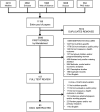A scoping review of research on policies to address child undernutrition in the Millennium Development Goals era
- PMID: 33926609
- PMCID: PMC10195300
- DOI: 10.1017/S1368980021001890
A scoping review of research on policies to address child undernutrition in the Millennium Development Goals era
Abstract
Objective: The breadth of research on the impact of nutrition-specific policies to address child undernutrition is not well documented. This review maps the evidence base and identifies gaps on such policies.
Design: We systematically searched Medline, Embase, PAIS Index for public policy, Scopus and Web of Science databases to identify eligible studies. Key study characteristics, including research design, type of policy, time span of policy before impact assessment, child age at outcome assessment and types of outcomes assessed, were abstracted in duplicate.
Setting: Low-, middle- and high-income countries.
Participants: Studies were eligible for inclusion if they aimed to assess the impact of population-level nutrition-specific policies on undernutrition among children under 10 years of age.
Results: Of the 5646 abstracts screened, eighty-three studies were included. A range of policies to address child undernutrition were evaluated; the majority were related to micronutrient fortification. Most studies were observational, reported on mandatory regional or sub-national polices, were conducted in high-income countries and evaluated policies within 1 year of implementation. A narrow set of health outcomes were evaluated, most commonly iodine deficiency disorders and neural tube defects.
Conclusions: Nutrition policies were commonly associated with improved child nutritional status and health. However, this evidence is primarily based on limited settings and on a limited number of outcomes. Further research is needed to assess the longer-term impact of a broader range of nutrition policies on child health, particularly in low- and middle-income countries.
Keywords: Child health; Micronutrients; Nutrition-specific; Policy; Scoping review.
References
-
- UNICEF Data (2019) Malnutrition. https://data.unicef.org/topic/nutrition/malnutrition/ (accessed December 2019).
-
- Black RE, Victora CG, Walker SP et al. (2013) Maternal and child undernutrition and overweight in low-income and middle-income countries. Lancet 382, 427–451. - PubMed
-
- SUN Movement (2016) SUN MOVEMENT Strategy and Roadmap (2016–2020). https://scalingupnutrition.org/wp-content/uploads/2016/09/SR_20160901_EN... (accessed January 2020).
Publication types
MeSH terms
Substances
LinkOut - more resources
Full Text Sources
Other Literature Sources
Medical


